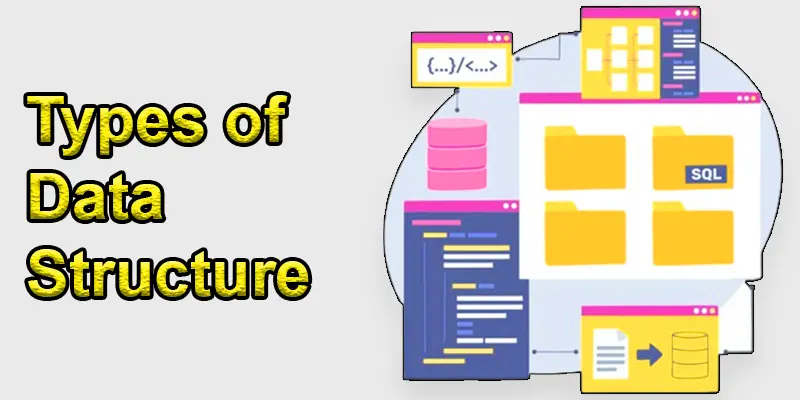What is a Data Structure? Definition Examples and Data Structure Types
Published: 6 Sep 2024
What is a data structure?
Information may be efficiently arranged and stored in a data structure. Imagine you have a big box of assorted items and need to find a specific one quickly. If you just throw everything into the box without any order, it will be hard to find what you need. But if you sort and categorize the items, like putting books on a shelf and toys in a bin, it becomes much easier to locate them. In the same way, data structures help us arrange and manage data in a computer so that we can access, modify, and use it more effectively.
Examples of Data Structures
Here are some common examples of data structures such as:
- Arrays: A list of items stored in order, like a list of numbers or names.
- Linked Lists: A chain of items where each item points to the next one, like a list of connected nodes.
- Stacks: A collection where you add and remove items from the top, like a stack of plates.
- Queues: A line where you add items at one end and remove them from the other, like a line at a checkout counter.
- Trees: A structure with branches that organize data hierarchically, like a family tree.
- Dictionaries: A collection of key-value pairs, like a real dictionary, where each word has a definition.
How are data structures used?
- Storing data efficiently: Data structures help store large amounts of information in an organized way, making it easier to manage.
- Searching for information: They make it faster and easier to find specific data, like looking up a contact in your phone by name.
- Sorting data: Data structures help sort information, like arranging names alphabetically or numbers in order from smallest to largest.
- Making data changes: You can add, remove, or update information easily with the right data structure.
- Solving complex problems: Data structures are used to tackle difficult tasks, like creating maps, organizing schedules, or developing games.

Why are data structures important?
- Efficient data management: They help save time and effort by helping to arrange and store data in a form that makes it easier to handle.
- Faster processing: Well-designed data structures allow computers to process tasks quickly, making programs run faster and more smoothly.
- Better use of memory: Data structures manage memory efficiently, ensuring that programs use only the space they need, which avoids slowing down the system.
- Easier problem-solving: They provide tools to solve complex problems, like searching through large databases or optimizing how information is displayed.
- Improved performance: Using the right data structure can significantly enhance the performance of applications, from websites to mobile apps.
Types of Data Structures
Different types of data structures, including queues, stacks, linked lists, hash tables, arrays and more.

Arrays
An array is like a row of boxes where each box holds a piece of information, such as a number or a word. Each box has a number called an index, which tells you where that specific item is located. You can quickly find or change an item by using its index. Arrays are useful when you want to store and access multiple pieces of information in an organized way.
Linked Lists
A linked list is like a chain of items, where each item is connected to the next one. Each item, called a “node,” holds the data and a link to the next node in the list. Unlike an array, items in a linked list don’t have to be next to each other in memory, and it’s easy to add or remove items by simply changing the links. This makes linked lists flexible and useful for tasks where the size of the data changes often.
Stacks
Similar to a pile of books, a stack allows you to just add or delete the book at the top. The last item you add is the first one you remove under the “Last In, First Out” (LIFO) scheme. You can think of it as stacking plates: the last plate placed on top is the first one you take off. Stacks are useful for tasks like undoing actions in a program or keeping track of recent tasks.
Queues
Similar to a line at the checkout, when the first person in line is served first, a queue is made up of people. It works on a “First In, First Out” (FIFO) principle, meaning the first item added is the first one to be removed. Imagine a queue as a line of people waiting for their turn—each person waits their turn in the order they joined. When handling requests or printing papers, for example, that must be completed in the order they arrive, queues can be quite helpful.
Hash Tables
A hash table is like a special kind of address book where each entry has a unique key, like a contact’s name, that helps you quickly find the information you need. Instead of looking through a long list, you use the key to jump straight to the right spot. This makes finding and storing data very fast. Hash tables are great for situations where you need quick access to items based on their unique identifiers.
Trees
A tree is like an upside-down tree with a main trunk (the root) that branches out into smaller branches and leaves. Each branch or leaf can also have its own smaller branches, creating a structure that organizes information in a hierarchical way. This setup is useful for representing things in a clear order, like family trees or folders on a computer. Trees make it easy to organize and find information by following the branches from the root down to the leaves.
Binary Trees
A binary tree is a unique tree in which every branch can have a maximum of two offshoots, known as the left and right child. This creates a branching structure that’s easy to navigate and search through. Each branch splits into two, like a series of yes/no decisions, making it efficient for sorting and finding information. Binary trees are useful for organizing data where you need to quickly locate or manage items based on their relationships.
Heaps
A heap is a special type of binary tree where each parent branch is always bigger (or smaller) than its children. This means the largest (or smallest) item is always at the top, making it easy to quickly find the most important item. Think of it like a pile of dishes where the largest dish is always on top. Heaps are useful for tasks like organizing and retrieving the top item efficiently, such as in priority queues or sorting algorithms.
Graphs
A graph is like a map showing points (called nodes) connected by lines (called edges). Each node can link to multiple other nodes, creating a network of connections. This setup is great for representing relationships or pathways, such as roads between cities or social connections between people. Graphs help visualize and solve problems involving complex connections and paths.
Tries
A trie is a type of tree used for storing words where each branch represents a letter. As you add words, you follow the branches according to each letter in the word. This makes it easy to find words quickly, especially when they share common prefixes. For example, in a trie, “cat” and “car” would share the same initial branches but diverge where the letters differ. Tries are useful for tasks like autocomplete suggestions or dictionary lookups.
How do I select the right data structures?
- Understand Your Data: Know what kind of data you have and how you need to use it. For example, do you need to store a list of items or track connections between them?
- Identify Operations: Think about the operations you’ll perform often, like adding, removing, or searching for data. Choose a data structure that handles these operations efficiently.
- Consider Performance: Look at how quickly you need these operations to be done. Some data structures are faster for certain tasks than others.
- Think About Memory: Consider how much memory you have available and how much the data structure will use.
- Evaluate Complexity: Some data structures are easier to work with and understand than others. Pick one that matches your level of expertise and the complexity of the task.
How do data structures work?
Data structures work by organizing data in a specific way to make it easier to use and manage.
- Storing Data: They provide a method for storing data, like putting items in different types of containers, such as boxes, lists, or folders.
- Organizing Data: They arrange data in a particular order or structure. For example, a list keeps things in sequence, while a tree arranges them in a hierarchy.
- Accessing Data: They allow you to quickly find and use the data you need. Some data structures let you search through data easily, while others make it simple to add or remove items.
- Efficient Operations: They are designed to make common operations—like adding, deleting, or finding data—faster and more efficient based on the type of data and what you need to do with it.

Conclusion about data structures
Data structures are essential tools for organizing data in a computer. They help store information efficiently, allow quick access to data, and make it easier to perform tasks like searching or updating. By choosing the right data structure for your needs, you can ensure that your programs run smoothly and handle data effectively. Whether you’re working with simple lists or complex networks, understanding data structures will help you build better and more efficient solutions.
FAQS – Data
What is a data structure in C?
A data structure in C is a means to store and arrange data so that you may work with it more conveniently. For example, arrays can be used to hold a list of integers, and structs can be used to organize various sorts of data.
What is a data structure in Python?
A data structure is a mechanism to store and organize data in Python. For example, you can use lists to store a sequence of items, dictionaries to keep key-value pairs, and sets to handle unique items.
What is a data structure in programming?
A data structure is a means to store and organize data in programming so that it is simple to use and administer. It facilitates effective data handling and manipulation within your programs.
What does data structuring mean?
Data structuring means organizing data in a specific way using data structures. This makes it easier to store, access, and manipulate the data in your programs.
What is a database structure?
A database structure is how data is organized and stored in a database. It includes tables, columns, and rows that help manage and retrieve data efficiently. For example, a table might store customer information with columns for names, addresses, and phone numbers.

- Be Respectful
- Stay Relevant
- Stay Positive
- True Feedback
- Encourage Discussion
- Avoid Spamming
- No Fake News
- Don't Copy-Paste
- No Personal Attacks

- Be Respectful
- Stay Relevant
- Stay Positive
- True Feedback
- Encourage Discussion
- Avoid Spamming
- No Fake News
- Don't Copy-Paste
- No Personal Attacks





